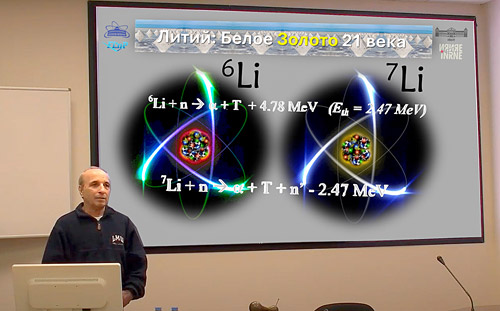
Electronic english version since 2022 |
The newspaper was founded in November 1957
| |
Seminars
Lithium - white gold and the mystery of the Universe
On 21 May, a popular science lecture by Ivan Ruskov (Institute for Nuclear Research and Nuclear Energy, BAS, JINR) was held at FLNP "Lithium: the white gold of the 21st century". The author gave an overview of current research trends and future areas of studying the interaction of neutrons with lithium nuclei. This topic is of exceptional importance in various fields, from the investigation of nucleosynthesis in the Universe to the production of lithium batteries and peaceful or military use of thermonuclear energy.

He started with describing the lithium fever that has increased concerning the "green" energy agenda announced in Europe. Lithium is currently declared a strategic raw material in both Russia and the United States. The "lithium triangle" includes the leading countries in terms of reserves of this metal Bolivia, Argentina and Chile. Russia has its own deposits, either mothballed or under development but there are also plans to build a lithium carbonate plant in Bolivia. Lithium is essential for the production of aluminum semi-finished products, electronics, laser equipment and is used in the aerospace and nuclear industries. Lithium is critical for the production of electric vehicle batteries. Research on lithium-ion batteries is not alien to FLNP, where it has been implementing for several years.
Lithium also has its own mystery: it is still impossible to explain the almost threefold excess of the theoretical estimate of Li-7 over its real availability in nature. The Big Bang theory predicts that when the Universe was developed, the only matter that occurred was hydrogen, helium and very small amounts of lithium. The lecturer cited papers on Big Bang nucleosynthesis and the problem of the prevalence of lithium in the early universe. The lecturer also presented the results obtained by Y.M.Gledenov and P.V.Sedyshev (FLNP JINR) together with the colleagues from the NRC "Kurchatov Institute" - PNPI (Gatchina) and ILL (Grenoble, France). These investigations concern the (non)violation of spatial parity in reactions of polarized neutrons with light nuclei (Li, Be, B) that is essential for understanding the mechanism of the weak interaction in nuclear processes, as well as for estimating the parameters of the weak nucleon-nucleon interaction.
Ivan Ruskov also spoke about different types of Li-6-based neutron detectors and their applications, as well as about the fact that the U.S. Department of Energy currently prepares to modernize Li-6 enrichment facilities, previously closed due to heavy contamination by mercury used in the enrichment process. This is due to the steadily increasing demand for lithium, not only because of its use in neutron detectors, but also in blanket breeders for tritium production in fusion power. The speaker reviewed different reactions with Li-6 and Li-7 to produce tritium and other thermonuclear fusion reactions.
We plunged into the history of the hydrogen and neutron bombs, heard the names of Oppenheimer, Teller, Cohen and the "fathers" of the Chinese atomic and hydrogen bombs - Deng Jiaxian and Yu Min. The device detonated on 1 March, 1954 at Bikini Atoll is still the most powerful nuclear device ever detonated by the United States and the first thermonuclear weapon containing lithium deuterite tested using the Teller-Ulam design.
Why do we need nuclear data in the first place? It is nuclear theory and technology required for the design and operation of nuclear reactors, fusion plants, climate research and nuclear astrophysics, medical applications, detector design and calibration, nuclear forensics, nondestructive testing applications, oil prospecting and life sciences. Nuclear forensics includes the investigation of materials used to attribute a nuclear event. Analysis of nuclear reaction products from both weapons and materials in the immediate vicinity of the event provides the data required for identifying the source of the nuclear material and the design of the weapon.
Ivan Ruskov focused on the issue of obtaining more accurate and reliable nuclear data on neutron reactions with lithium. These data are essential for expanding the understanding of the mechanisms of nuclear reactions and their practical applications. The speaker shared his experience in measuring the very important cross section of the 6Li(n,t)4He reaction at the GELINA facility (Belgium). He cited several papers by different teams of authors on this reaction that is one of the most important nuclear reactions since it produces tritium, a key material for fusion energy production. It is also used as a standard in the experimental determination of cross sections of other neutron-induced nuclear reactions.
The speaker compared the results on the measurement of the 6Li(n,t)4He reaction cross section in the 4.25-7.5 MeV energy range obtained by P.S.Prusachenko (FLNP) and T.L.Bobrovsky (IPPE, Obninsk) that were presented by P.S.Prusachenko at the ISINN-30 Conference last year, with previously published data of other authors.
Ivan Ruskov highlighted that at the Technical Meeting on Neutron Data Standards held in January this year at the IAEA (Vienna), the relevance of obtaining new experimental data on n6Li (7Li system) cross sections up to 8 MeV was emphasized. And in April, measurements of 6Li(n,t)α, 7Li(n,n't)α and 9Be(n,2n)2α reactions at the n-TOF neutron time-of-flight spectrometer (CERN) were proposed, with the aim of obtaining improved cross sections required for calculations of tritium reproduction in some of the most promising nuclear reactor designs. Currently, a team of scientists from two universities and two national laboratories in the USA measures cross sections of (n,xnγ) reactions using the technique of tagged neutrons, similar to those carried out in the framework of the TANGRA project at FLNP JINR.
At the end of the seminar, Ivan Ruskov congratulated everyone on the coming St. Cyril and Methodius Day, the Day of Slavonic Script and Culture, as well as on our wonderful alphabet (Az, Buki, Vedi...) that encrypts the message from our ancestors to all of us.
Olga TARANTINA